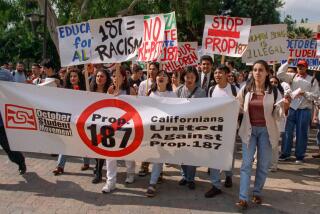Tolerance: Why Schools Must Lead : Tension in Orange County reveals the danger
Since this country’s beginning, there have been many unfortunate clashes of cultures between new immigrants and established groups. In recent decades, however, suburban high schools were all but insulated from the tensions that raged in many inner-city schools. No more in the multicultural 1990s. Schools that used to be almost entirely white are now having problems as whites and minorities--a term for Latinos, blacks and Asians that actually is a misnomer in California--clash in suburbia.
Emotions and violence flared last week in Orange County, when a verbal confrontation between a white and an Asian-American student at Fountain Valley High School escalated into a brawl that led to the stabbing of one student--in the head, with a pencil--and eventually suspension of 22 students.
Ugly racial and ethnic confrontations on the schoolyard are cropping up all over the nation. In Southern California especially, Asian-American and Latino students now line up beside Anglos for educational opportunities in school systems that never had to pay very much attention to how everybody got along. That won’t do any longer.
These schools must resolve to combat cultural ignorance head-on by teaching youngsters how to get along with others from different backgrounds.
This is not to single out Fountain Valley High School. Last month, some of the school’s farsighted teachers, students and parents formed a human relations committee to build understanding. That’s a commendable start.
But building understanding takes time and resources--in an era of stretched finances. So what else can school systems do? Here are a few suggestions. When hiring does return, recruit more minority faculty members. Firmly discipline the few students who spoil the atmosphere for the many. Encourage local police departments to improve relations with minority communities. Institute a grievance system to defuse tensions. Work with county human relations commissions.
And most of all, create an atmosphere where young people can talk. That’s vital. We can’t embed tolerance in the genetic coding of parents or convert all bigots into models of acceptance. But we can point the way.
What’s necessary is to enlist parents, teachers, administrators and students in a program to build ethnic understanding into the culture of the schools. That would be a powerful start toward shaping an inheritance of enlightenment and tolerance.
Period of Adjustment 1987-88 Anglo: 73.7% Other: 5.3% Asian: 15.4% Latino: 5.2% Black: 0.4% 1992-93 Anglo: 56.9% Other: 9.6% Asian: 26.4% Latino: 7.4% Black: 1.0%
More to Read
Sign up for Essential California
The most important California stories and recommendations in your inbox every morning.
You may occasionally receive promotional content from the Los Angeles Times.










